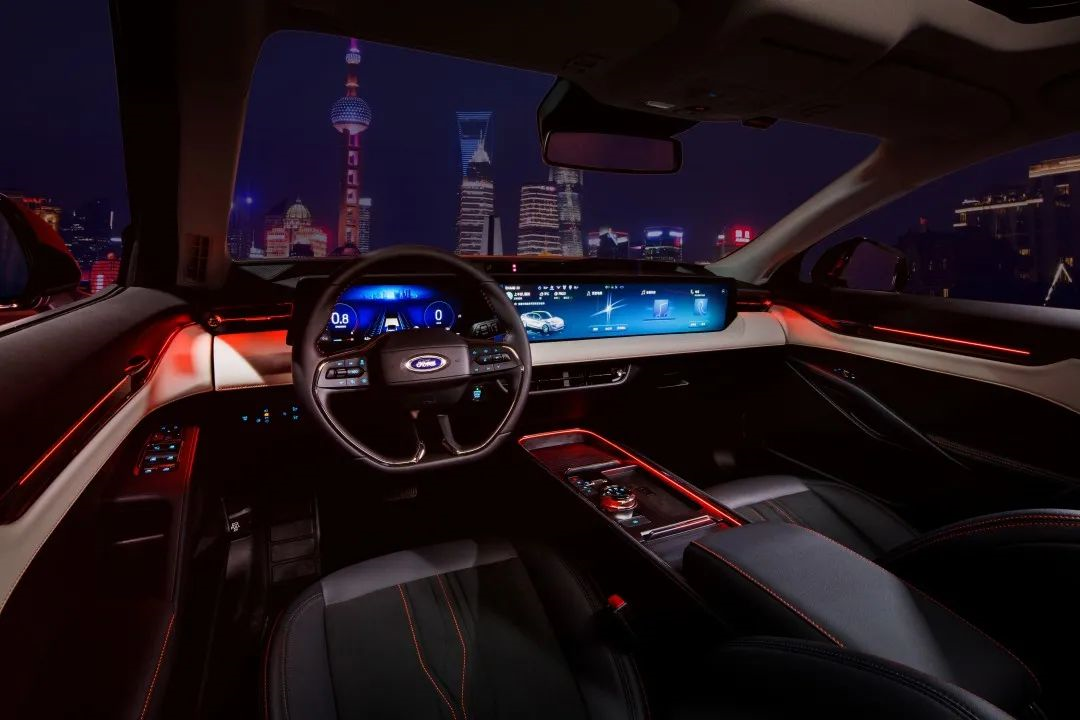Author: Michelin
What is an intelligent cabin? In different times, everyone has a different answer.
A few years ago, the answer to this question may have been real-time navigation, the ability to listen to music without using CDs or U disks, and touch screens and voice interaction inside the cabin. It may have been the convenience brought by the online cabin system.
What about the future? When the screens inside the cabin become larger and clearer, the application ecosystem becomes richer and the sensors and AI brains become “smarter”, will the definition of the cabin be based on the “hard power” that is constantly added or the different experiences that they bring to users?
Coinciding with Ford’s Digital Experience Day, we visited the Ford Intelligent Network and Digital Experience Team (ECDX) located in Shanghai’s “Ford Innovation Valley” with these questions and saw how Ford explores and defines its own intelligent cabin on the digital road.
Perceptible Intelligence, Imperceptible Service
When it comes to smart cars, people often compare them to the evolution of smartphones. Just as phones have evolved from simple communication tools for making calls and sending messages to intelligent terminals nowadays, the development of smart cars has also led to more diverse functional attributes beyond pure transportation.
So, what is intelligence? According to the Ford ECDX team, intelligence is divided into two parts: capabilities and perceptions.
For cars, those more open electronic architectures, enhanced perceptual capabilities, and computing power are the basis of intelligence, and the fundamental of intelligent vehicles. However, how to utilize these capabilities and provide better cooperative services to users are the perceptions of intelligence conveyed by cabins to users.
As technology has developed to today, there are almost no unique, unshareable underlying technologies or functions, just like the cabins loaded with 8155 chips that appeared like mushrooms after the rain last year. But the experience created for each product with the same cabin and underlying architecture is unique, and cannot be replicated. These experiences come from the optimization of visual effects, the polishing of interaction logic, and the handling of product details. They combine to provide users with accessible and thoughtful intelligence as well as attentive service.Looking back at the dozens of intelligent cabins reviewed by GeekCar in 2021, a striking impression was the 1.1-meter long screen. Despite the trend of increasingly large and numerous cabin screens, such a long screen design still looks very bold. Compared with commonly seen dual screens, the biggest difference of this 1.1-meter ultra-wide screen is that through the free switching of the ultra-long screen split-screen and full-screen, the main and co-pilots can cooperate with each other. In this state, the main and co-pilots have equal access to information and cabin control, as well as mutual cooperation.
On this Innovation Day, we also saw optimization in existing products in the areas of voice interaction and in-vehicle application ecology.
The “visible speech” capability of voice interaction covers the entire scene, reaching deeper levels of interaction with third-party apps and mini-programs, and can also interact with the in-car voice assistant VPA partner in multi-round interactions without awakening, achieving more accurate and smoother responses. It avoids the situation of having to switch to manual operation after using voice interaction to open some functions while driving, and does not require memorizing special “commands” or “gestures”, but operates naturally based on daily habits.
In the mid-term planning concept of the intelligent cabin, the 1.1-meter long screen has become a “scroll”, not only laying out 80% of the commonly used functions on the central control homepage, achieving zero-level interaction, but also allowing each function of the homepage to be within reach of the driver’s comfortable position for operation.
After all, the design of an intelligent cabin is to enable users to use the cabin, rather than letting the cabin steer the users.
“Third space” has been repeatedly mentioned since the appearance of intelligent cabins, with different themes such as “sleeping space”, “office space”, “gaming space”, etc. envisioned for the future. However, just like how smartphones have ultimately replaced short-term products such as “music phones” and “camera phones”, the functions and scenes of cabins are not singular themes, and people’s demands for a car cabin are not unchanging. Rather than making users adapt to different cabin scenes, it is better to provide an open and selectable space.When gathering with friends, the cabin can be transformed into a private space for mobile KTV, gaming center, and friend gathering, by connecting intelligent microphones and game controllers. During self-driving trips, the cabin can become an adventure partner by connecting with smart hardware like drones and Go-Pros. When camping outdoors, singing karaoke with external microphones on the in-car central control screen, coupled with in-car cameras, ambient lights and programmable intelligent headlights, creates an atmosphere that is full of light show.
Just as Ford envisions for the intelligent cabin of the future, perhaps we will no longer need huge touch screens. Systems can provide us with services through voice, eye contact, and even reminders and call logs from notebooks; communication between people and systems will no longer require soft and cute anthropomorphic intelligent assistants. The intelligent vehicle itself is the embodiment of intelligence.
The intelligent life cabin is like a new open car digital platform that can create different themes through digital module software and hardware, and cultivate continuously upgraded intelligent cabin digital experience.
Intelligently Moving Forward at Full Speed
Recently, the biggest news about Ford may be the “One for Three” in its automotive business unit: Ford’s fuel car business, electric car business, commercial vehicle and related service businesses will operate independently and be self-sustaining since 2023.
It has to be said that for traditional car companies with deep roots in the fuel car field, this is a “make-or-break” decision and the determination to transform into electrification and intelligence. On the road to electrification and electrification, an important stronghold cannot be avoided–the Chinese market.
-
“How to achieve localization?”
-
“How to work with the Ford headquarters and hold the discourse power?”
For every car company that caters to both domestic and foreign markets, this is an unavoidable issue.
“Domestic customers have higher requirements for the in-car digital experience than foreign customers.” Ford ECDX Vice President Fang Yuliang described the demand for intelligent cabins in the Chinese domestic market. Domestic users and markets have more rapid, intelligent and flexible demands for cabins, and the cabin experience itself also varies due to the usage habits of users in different regions.Due to changes in demand, Ford merged their EC (Intelligent Network Connectivity) and DX (Digital Experience) teams in January 2021 to establish a dedicated Intelligent Network Connectivity and Digital Experience team, ECDX. This team focuses on innovation, development, and delivery of intelligent cockpit products throughout the entire supply chain, covering most of Ford and Lincoln’s domestically produced models in China. Within a year, the ECDX team tripled in size, with members from various fields, including the automotive industry, internet, and technology companies, contributing diverse cultural and agile development perspectives to the creation of intelligent cockpits and the digital transformation of traditional automobile enterprises.
These innovative design ideas will also be fed back to Ford’s other markets.
Finally
It is unclear when traditional car manufacturers became “conservative” in the wave of intelligent vehicles, but Ford’s understanding of the digital experience of intelligent cockpits and the creation of an exclusive team, as well as the establishment of their electric vehicle business, demonstrate the company’s determination and ambition.
From cars to intelligent electric vehicles, simplistic functionality will no longer serve as the guiding ideology for product development. Understanding user experience and usage scenarios have become the starting line and beyond for all, extending to a racetrack.
Of course, there remain many issues to address in this industry. For example, how to resolve the increasing requirement for system computing power? How to make the rich ecological environment inside the cockpit truly functional and not just a “trial and error” feature? How to effectively address the “internal competition” of intelligent cockpits? These are challenges Ford face on their road to defining the intelligent cockpit, but they also represent opportunities for turning trends into advantages.

This article is a translation by ChatGPT of a Chinese report from 42HOW. If you have any questions about it, please email bd@42how.com.
